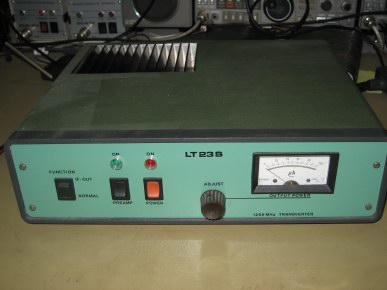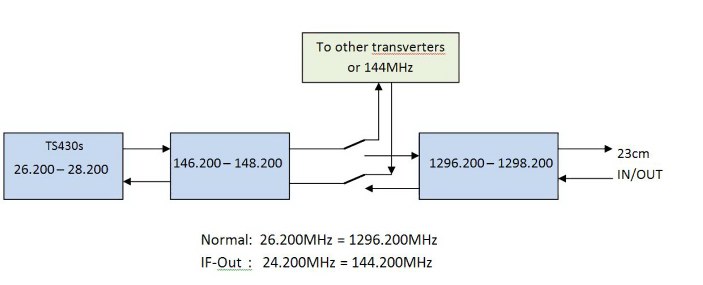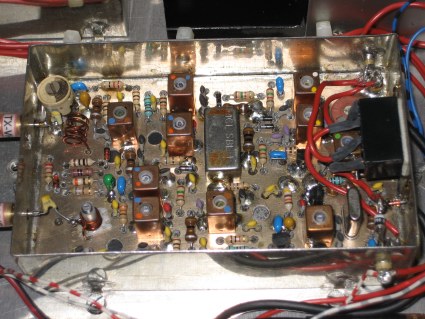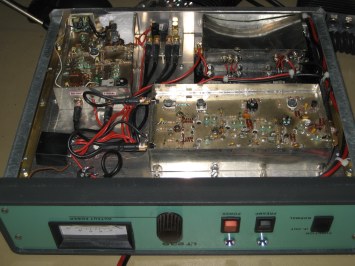23cm_transverter
The 23cm transverter follows the same principle to prevent breakthrough as described in the 13cm transverter. This principle is were possisble to prevent exactly 144Mhz signals for IF. This 23cm transverter is using a two-stage principle: first is to step from the IF-transceiver at 10m. to VHF, and the second step is from VHF to UHF.
There are a few words needed to explain this: My IF-transceiver I planned to use is a TS430s. This transceiver has a transverter output at its rear. But what happens when simply using the normal approach and start at 28.200MHz to transvert to 23cm? That would mean that the indication on the display of the tranceiver is not showing the correct MHz-value: 1296.200 would be indicated as 28.200MHz. Wouldn't it be great to have 26.200MHz shown at the transceiver when working 1296.200MHz? I think yes! The MHz-indication exactly matches the MHz-indication at the 23cm operating frequency. For this reason I ordered special oscillator-crystals for the transverter(s).
A second item I would like to bring under attention is the use of 144MHz as IF in a transverter. When using a multi-multi setup in a fieldday or contest environment, it is very disturbing to hear your neighbor \t the 144MHz location calling CQ, when you want to operate 23cm or 13cm. For that reason I shifted the second IF 2MHz away from 144MHz and use 146MHz.
 In this picture the 23cm transverter is shown. It is build in a nice Shubert housing. The visual appearance of homemade equipment is also important isn't it?
I use type indication like LT23s, to people familiar to transverters this indication must be seen in commercial transverters before hihi...
At the front-panel some essential controls can be seen: ON/OFF, Preamp ON/OFF, output power set and a indication for relative output power (current in final stage). A selection knob for IF-out/Normal selects the transverter s' first stage to relay the VHF first IF to the rear outputs. This option enables the transverter to operate from 26MHz to 146MHz and connect an other transverter (13cm or 6mtr). When selecting 'Normal', the first IF inside the 23cm transverter is connected to the VHF/SHF part and anables this transverter for 23cm.
To clarify the above I made a small sctech to explain:
 Because the TS430s transceiver is not locked at it's transverter-port to explicit HAM-bands, it can operate also below 28.000MHz (10mtr. lower limit in Europe). That opened the described possibilities. To operate the option to connect an external 144MHz PA and mastmount preamp, simply change the TS430s' operation frequen cy to 24.200MHz and I can operate at 2mtr. The nice thing is that again the display at the TS430s is showing the MHz-correct indication for 2mtr. operation.
 The first stage in the 23cm transverter is the HF/VHF box. Inside here the 10mtr. signals are mixed up/down to 146Mhz.
It uses a IE500 pasive mixer, a local oscillator and receive preamp. The same transverter HF/VHF I used in the 6mtr. transverter that is descibed in the 6mtr. section.
It must be said that because of the design, the performance (output-power as well as sensitivity) is not the same when using this intermediate stage at 144MHz and 148MHz. But because these are only intermediate signals, the performance of the 23cm transverter is determined at other locations like the mastmount preamp.
 As can be seen from the blok-diagram, this transverter block is connected to a second transverter that converts the signals up/down to 23cm. The 23cm signals are made in the wellknown SSB-electronics building blocks UEK-3 transmit converter and USM-3 receive converter.
These two boxes are build in the bottom-side of the Shubert housing. The USM-3 is mounted in such a way that the antenna-connector is pointing to the rear-outside. The UEK-3 transmit converter ia mounted more to the centre of the housing, leaving enough space for the Mitsubishi power-module. This module boosts the UEK-3 1W output to almost 20W.
The USM-3 receive converter also holds the local-oscillator for both the receive and the transmit converter. Like in the 13cm transverter, also this oscillator is equipped with a TCXO, a temperature controlled crystal oscillator to ensure temperature stabillity. This option was not a standard solution from SSB-elektronics.
|